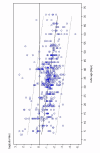Kinetics of maternal immunity against rabies in fox cubs (Vulpes vulpes)
- PMID: 12069694
- PMCID: PMC116597
- DOI: 10.1186/1471-2334-2-10
Kinetics of maternal immunity against rabies in fox cubs (Vulpes vulpes)
Abstract
Background: In previous experiments, it was demonstrated that maternal antibodies (maAb) against rabies in foxes (Vulpes vulpes) were transferred from the vixen to her offspring. However, data was lacking from cubs during the first three weeks post partum. Therefore, this complementary study was initiated.
Methods: Blood samples (n = 281) were collected from 64 cubs (3 to 43 days old) whelped by 19 rabies-immune captive-bred vixens. Sera was collected up to six times from each cub. The samples were analysed by a fluorescence focus inhibition technique (RFFIT), and antibody titres (nAb) were expressed in IU/ml. The obtained data was pooled with previous data sets. Subsequently, a total of 499 serum samples from 249 cubs whelped by 54 rabies-immune vixens were fitted to a non-linear regression model.
Results: The disappearance rate of maAb was independent of the vixens' nAb-titre. The maAb-titre of the cubs decreased exponentially with age and the half-life of the maAb was estimated to be 9.34 days. However, maAb of offspring whelped by vixens with high nAb-titres can be detected for longer in RFFIT than that of offspring whelped by vixens with relatively low nAb-titres. At a mean critical age of about 23 days post partum, maAb could no longer be distinguished from unspecific reactions in RFFIT depending on the amount of maAb transferred by the mother.
Conclusions: The amount of maAb cubs receive is directly proportional to the titre of the vixen and decreases exponentially with age below detectable levels in seroneutralisation tests at a relatively early age.
Figures




Similar articles
-
Kinetics of humoral immune response after rabies VR-G oral vaccination of captive fox cubs (Vulpes vulpes) with or without maternally derived antibodies against the vaccine.Vaccine. 2001 Sep 14;19(32):4805-15. doi: 10.1016/s0264-410x(01)00211-0. Vaccine. 2001. PMID: 11535333
-
The persistence of rabies virus antibodies in the sera of fox cubs.J Vet Med B Infect Dis Vet Public Health. 2003 May;50(4):204-6. doi: 10.1046/j.1439-0450.2003.00660.x. J Vet Med B Infect Dis Vet Public Health. 2003. PMID: 12916696
-
Origin of maternally transferred antibodies against rabies in foxes (Vulpes vulpes).Vet Rec. 2003 Jul 5;153(1):16-8. doi: 10.1136/vr.153.1.16. Vet Rec. 2003. PMID: 12877212
-
Effect of maternal immunity on the immune response to oral vaccination against rabies in young foxes.Am J Vet Res. 2001 Jul;62(7):1154-8. doi: 10.2460/ajvr.2001.62.1154. Am J Vet Res. 2001. PMID: 11453495
-
Efficacy and bait acceptance of vaccinia vectored rabies glycoprotein vaccine in captive foxes (Vulpes vulpes), raccoon dogs (Nyctereutes procyonoides) and dogs (Canis familiaris).Vaccine. 2008 Aug 26;26(36):4627-38. doi: 10.1016/j.vaccine.2008.06.089. Epub 2008 Jul 11. Vaccine. 2008. PMID: 18620017 Review.
Cited by
-
In Vivo Safety Studies With SPBN GASGAS in the Frame of Oral Vaccination of Foxes and Raccoon Dogs Against Rabies.Front Vet Sci. 2018 May 18;5:91. doi: 10.3389/fvets.2018.00091. eCollection 2018. Front Vet Sci. 2018. PMID: 29868616 Free PMC article.
-
Deciphering serology to understand the ecology of infectious diseases in wildlife.Ecohealth. 2013 Sep;10(3):298-313. doi: 10.1007/s10393-013-0856-0. Epub 2013 Aug 6. Ecohealth. 2013. PMID: 23918033 Review.
-
Optimizing spatial and seasonal deployment of vaccination campaigns to eliminate wildlife rabies.Philos Trans R Soc Lond B Biol Sci. 2019 Jul 8;374(1776):20180280. doi: 10.1098/rstb.2018.0280. Philos Trans R Soc Lond B Biol Sci. 2019. PMID: 31104608 Free PMC article.
References
-
- Stöhr K, Meslin FX. Progress and setbacks in the oral immunisation of foxes against rabies in Europe. Vet Rec. 1996;139:32–35. - PubMed
-
- Müller T, Schlüter H. Oral immunization of red foxes (Vulpes vulpes) in Europe – A review. J Etlik Vet Microbiol. 1998;9:35–59.
-
- Breitenmoser U, Kaphegyi T, Kappeler A, Zanoni R. Significance of young foxes for the persistence of rabies in northwestern Switzerland. Immunbiology of viral infections. Proceedings of the 3rd Congress of the European Society of Veterinary Virology. 1995. pp. 391–396.
-
- Müller T, Schuster P, Wenzel U, Vos A, Selhorst T, Neubert A. Maternal immunity and the immune response of fox cubs (Vulpes vulpes) to oral vaccination against rabies. Proceedings of the 10th Annual Rabies in the Americas Meeting, Novenber 14–19, San Diego, USA. 1999. p. 83.
MeSH terms
Substances
LinkOut - more resources
Full Text Sources
Medical

